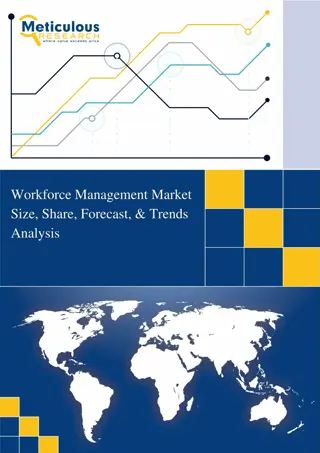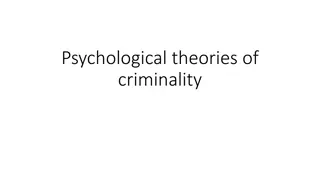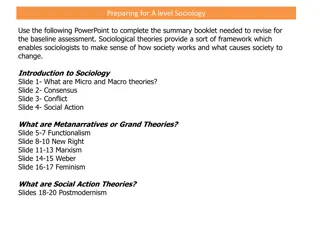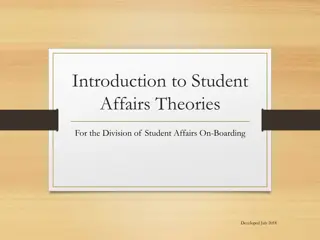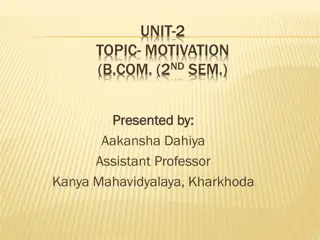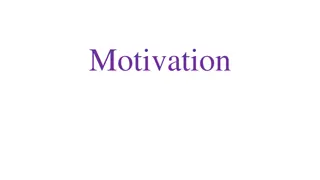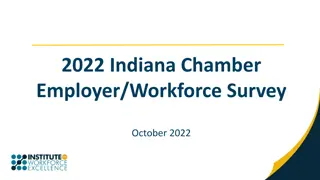Motivation in the Workforce: The Key Theories
Motivation in the workforce is crucial for business success. Explore key theories like Maslow's Hierarchy of Needs, Herzberg's Dual Factor Theory, and Taylor's Scientific Management. Learn about financial and non-financial motivators influencing employee performance and job satisfaction. Discover how different theories attempt to explain and influence human behavior in the workplace.
Download Presentation

Please find below an Image/Link to download the presentation.
The content on the website is provided AS IS for your information and personal use only. It may not be sold, licensed, or shared on other websites without obtaining consent from the author.If you encounter any issues during the download, it is possible that the publisher has removed the file from their server.
You are allowed to download the files provided on this website for personal or commercial use, subject to the condition that they are used lawfully. All files are the property of their respective owners.
The content on the website is provided AS IS for your information and personal use only. It may not be sold, licensed, or shared on other websites without obtaining consent from the author.
E N D
Presentation Transcript
D1 Recap: MOTIVATION INTHE WORKFORCE What is meant by motivation? Explain 3 numerical techniques used to measure workforce performance. What would be the features of your perfect job? LEARNING AIM D: FACTORS INFLUENCING MANAGEMENT, MOTIVATION AND PERFORMANCE OF THE WORKFORCE
MOTIVATIONINTHEWORKPLACE In this topic you will learn about Theories of motivation (A Maslow, F Herzberg, F W Taylor, E Mayo et al) Impact of motivation on business performance Financial motivators Non-financial motivators
THEORIESOFMOTIVATION Theories of motivation include: Why is it difficult to explain what motivates employees in the workplace? Maslow s hierarchy of needs Herzberg s two factor theory Taylor s scientific management Mayo s human relations theory Each theory attempts to explain the key influences on human behaviour
MASLOW HIERARCHYOF NEEDS Maslow s hierarchy of needs is based on seeing human needs as being placed in order, each need must be fulfilled before one could move on to the next American Maslow belongs to the Neo- Human relations school of management. Employees can be motivated by being presented with the opportunity to achieve the next level He is well known for his hierarchy of needs. Higher order needs Lower order needs
HERZBERG DUAL FACTOR THEORY American Herzberg introduced the notion of job enrichment. In 1959 he proposed the Two factor theory of job satisfaction. Job satisfaction is a key factor leading to motivation Job satisfaction could be influenced both positively and negatively Motivating factors Hygiene factors if present, lead to job satisfaction and hence motivation achievement, recognition, work, responsibility, promotion and growth if present do not lead to motivation but if absent lead to dissatisfaction pay and benefits, company policy, workplace relationships, work conditions, status and job security Jumping for Jelly Beans.
FREDERICK WINSLOW TAYLOR Taylor believed that workers were not capable of understanding their tasks and should follow strict rules on how to produce products American Taylor is seen as the father of Scientific Management . All tasks should be studied scientifically using a study of time and motion The most efficient way of carrying out a task will hence be identified Each employee can then be trained and instructed in exactly how to do a job in the most efficient manner Workers should be closely supervised Write a definition for each of the terms shown in purple. He coined the term economic man believing money is the key to motivation His ideas are linked to piece rate, the division of labour and mass production He is criticised for making jobs tedious
GEORGE ELTON MAYO Believed that workers must be seen as members of a group not as individuals He emphasised the informal work group as the means to improving productivity He believed that workers had social needs and that these should take precedence over other areas such as money as a motivator Changes in working conditions and financial incentives have little impact on labour productivity In his Hawthorne experiments he looked at the power of informal, as opposed to formal, groups as a basis for production in the workplace His findings were that motivation can be improved by: Consultation Paying an interest in workers Team work Some degree of autonomy in one s working day e.g. break times Australian Mayo looked at the importance of human relations in the workplace.
IMPACTOFMOTIVATIONONBUSINESS PERFORMANCE Benefits: Higher labour productivity Lower labour turnover How would you keep workers happy? Higher retention rates Discuss how these will impact on the financial performance of a business. Lower unit costs Lower absenteeism Reduced presentism Improved customer service Better quality products Better workplace relations
INPAIRS Select one business or industry Identify a range of jobs within that business or industry Explain what motivates employees in each of the jobs with reference to the 4 motivational theorists How useful do you think motivational theories are in understanding workplace behaviour?
TESTYOURSELF - 4 MINUTES Explain Taylor s theory of scientific management. Underline or highlight each business term used in your explanation. End
TESTYOURSELF - 4 MINUTES Explain Herzberg s two factor theory. Underline or highlight each business term used in your explanation. End
TESTYOURSELF - 4 MINUTES Explain Maslow s hierarchy of needs. Underline or highlight each business term used in your explanation. End
TESTYOURSELF - 4 MINUTES Explain Mayo s human relations theory. Underline or highlight each business term used in your explanation. End
MOTIVATORS Financial motivators are the variety of methods that have a money value and are used to reward the workforce and influence their behaviours at work Non-financial motivators are the methods of motivating employees through elements of job design Does money really motivate people?
FINANCIALMOTIVATORS Which motivational theorist would be in favour of piece rate pay as a financial motivator? Financial methods of motivation include: Piece rate is when payment is based on the number of items (pieces) produced by an employee Commission is when payment is based on the number of units sold Bonus is an additional, lump sum, one off payment to an employee for meeting individual, team or company targets Profit share is when a proportion of employee pay varies with the profits of the company Which financial method would motivate you? Performance related pay (PRP) is when employees receive a bonus based on the performance of the employee measured against a pre agreed range of criteria Could these be applied to sixth form studies?
NON-FINANCIALMOTIVATORS Delegation involves the passing of authority down the hierarchy Authority occurs when an employee is given the right to do something by their superiors Responsibility remains with the manager This will: free up time for management motivate workers by providing them job enrichment may mean that decisions are being made closer to the grass roots
NON-FINANCIALMOTIVATORS Discuss how each of these techniques could improve motivation. Consultation is the process of seeking the thoughts and opinions of employees prior to making decisions that may affect them Empowering employees involves delegating responsibility to employees, allowing them to use their abilities and to have a greater say in the decision-making process of the company Team working is where employees are organised into groups and work together in order to meet set objectives Flexible working gives employees greater control over their own work routines e.g. start and finish time, may include the ability to work from home
NON-FINANCIALMOTIVATORS Job enrichment is an increase in the level of responsibility that an employee has in order to increase motivation Job rotation is varying the tasks that an employee does to reduce boredom and increase the range of skills that the worker has What would be the most effective way of attracting doctors into general practice? Job enlargement is an increase in the number, as opposed to level, of responsibilities that an employee has in order to increase motivation
TESTYOURSELF - 4 MINUTES With the use of examples distinguish between financial and non-financial incentives. End
INPAIRSDRAWTHEGRIDBELOWONTO A3 PAPERANDCOMPLETEWHEREAPPROPRIATETO EXPLAINTHELINKSBETWEENTHEMOTIVATIONAL TECHNIQUESANDTHEORIES. Taylor Mayo Maslow Herzberg Financial incentives Delegation Consultation Empowerment Team working Flexible working Job enrichment, rotation and enlargement
MOTIVATIONINTHEWORKPLACE In this topic you have learnt about Theories of motivation (A Maslow, F Herzberg, F W Taylor, E Mayo et al) Impact of motivation on business performance Financial motivators Non-financial motivators





